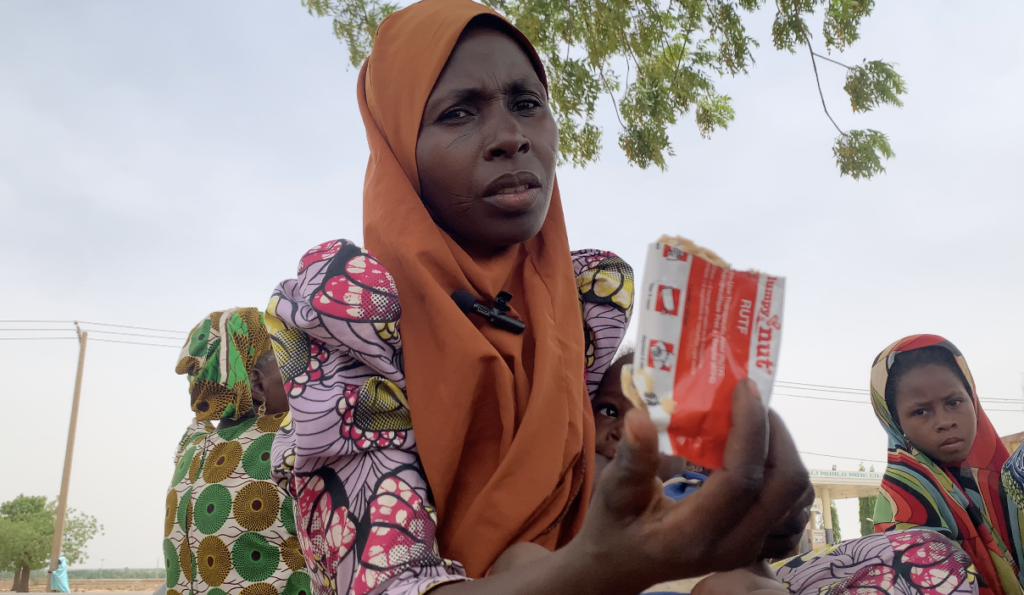Hassana and Hussaina are turning two soon. They are playing around their mother’s legs as she speaks about being displaced and how her daughters have been malnourished.
They were six months old in their mother’s belly when she and her family fled from Batagarawa Local Government Area of Katsina, a state in northwestern Nigeria, due to armed violence.
Being displaced suddenly plunged them into poverty. “We fled with nothing,” Rasheeda, their mother, says, and without access to their means of livelihood. There has also not been adequate aid assistance for them.
Rashida’s family began to experience long stretches of hunger where they would starve for days, “even if we get food it is never enough. If we eat in the evening, we might not eat in the morning. If we eat in the morning, we will not eat in the evening,” she says. “Every day it is like that.”
Due to the lack of sufficient nutritious food in Rashida’s body, Hassana and Husseina were born with extreme low-birth weights.
There is always a high tendency of low birth weight in pregnant women who do not eat enough, Julian Dadzie, a clinical nutritionist explains. She adds “hungry mothers do not have enough nutrients to help with the [foetal] development.”
Hassana and Husseina did not grow much even after their birth and this made Rashida worried. She says she was referred to a malnutrition centre near her and the twins were diagnosed with severe acute malnutrition.
Since then, the twins have gotten medical support from the centre giving malnourished children a fighting chance.
Acute Malnutrition Management
Katsina is one of the states in Nigeria’s northwest that has come under attacks by armed groups and it has resulted in the highest number of displacements in the region.
While it has pushed many to experience an unprecedented humanitarian crisis, children are bearing the brunt of it.
In a week, Rashida and her daughters are only certain of getting food handouts just twice – on Wednesdays and on Sundays. Even then, it is shared amongst other family members, and this is the reality of most internally displaced persons.
The state also accounts for the highest rate of stunting in Nigeria with over 200,000 children under the age of five suffering from either moderate acute malnutrition (MAM) or severe acute malnutrition (SAM). To respond to this, community-based management of acute malnutrition centres known as C-MAM Centres were set up across various communities.
Acute malnutrition tends to affect the physical and mental well-being of those affected. Dr Abdulkadir Yasore, the team lead in one of the malnutrition centres in Bastari community states that “some are so badly affected that whatever is handed to them they will take it to their mouths.”
When children are brought to the centre, Yasore says they are screened with MUAC tapes. Mid-Upper Arm Circumference or MUAC is a measuring tool that allows health workers to determine if a patient is acutely malnourished and to what extent.
During the screening, when a patient’s measurements is less than 11cm, it is an indicator that it is severe acute malnutrition. When it is up to 12.5cm, it is moderate acute malnutrition. This is when the affected child is referred to a stabilisation centre or put on Ready-to-use Therapeutic Food or RUTF.
When MUAC is between 12.5cm and 13.5cm, it suggests that the patient is at risk and their caretakers are counselled on how to promote the child’s nutrition. A MUAC of over 13.5cm indicates that the child is well nourished.
The next step when a child is experiencing SAM or MAM is an appetite test. “We instruct the mother or caregiver to wash their hands properly, then we give them a cup of milk and tell them to feed the child,” Yasore says, adding that, “if the child is able to drink three-quarter of the milk that means the child can still eat if the child is unable to drink we refer them to a stabilisation centre.”
The stabilisation centres are in-patient units where acutely malnourished children are constantly supervised until their MUAC is at least above 13cm. Rashida was discharged from the centre a day before she was interviewed for this report. “We spent nine weeks there getting treated,” she said.
RUTF is also given during discharge to help children fully regain their appetite. RUTFs, popularly known in the community as Dan Kwamaso, are a peanut-based paste that contains various nutritional components, “it is like a balanced food; with peanuts, soya beans, folic acids and other elements that can boost the children’s health,” Yasore explains.

Obstacles
While the centre is free for all, Abdulkadir Yasore says that mothers do not understand how the MUAC works. He explains that when mothers are told that their child is not malnourished at all they tend to become angry.
“When some mothers find out their child is fine, they will give thanks to God and leave but there are some who will accuse our team of lying and demand for the RUTFs,” he notes.
Although Yasore does not suggest that mothers resell the RUTFs, their accessibility and distribution have been a subject of public discourse in the malnutrition programme space.
Mothers have been accused of deliberately starving their children to get RUTFs. In places like Maiduguri, in the northeast, it is alleged that mothers go as far as poisoning their children to obtain RUTFs and then sell them for money.
However, Medecins Sans Frontieres/Doctors Without Borders (MSF) debunks these accusations, “any complete cartons found at resale sites are likely the result of diversion by people working in the health system, NGO workers, UN agencies or the Ministry of Health, because mothers have no access to whole cartons, only to individual sachets.”
Moreover, there are eight to 10 C-MAM centres across 15 local government areas in Katsina but in the midst of ongoing hunger, they do not provide a long-term or permanent solution to the malnutrition crises. Rashida says that in the span of just one year, her twins have been admitted to these centres thrice.
Support Our Journalism
There are millions of ordinary people affected by conflict in Africa whose stories are missing in the mainstream media. HumAngle is determined to tell those challenging and under-reported stories, hoping that the people impacted by these conflicts will find the safety and security they deserve.
To ensure that we continue to provide public service coverage, we have a small favour to ask you. We want you to be part of our journalistic endeavour by contributing a token to us.
Your donation will further promote a robust, free, and independent media.

